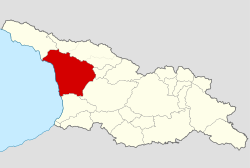Mingrelia
This articleneeds additional citations forverification.(May 2021) |
Mingrelia
სამეგრელო | |
|---|---|
 | |
| Coordinates:42°34′30″N41°40′40″E/ 42.57500°N 41.67778°E | |
| Country | |
| Largest city | Zugdidi |
| Area | |
| • Total | 9,983 km2(3,854 sq mi) |
| Population (2011) | |
| • Total | 522,019 |
| • Density | 52/km2(140/sq mi) |
| Mingrelia is not an official subdivision of theGeorgia;it constitutes ahistorical regiononly. | |
Mingrelia(Georgian:სამეგრელო,romanized:samegrelo;Mingrelian:სამარგალო,romanized:samargalo;Abkhaz:Агырны,romanized:Agirni) is a historic province in the western part ofGeorgia,formerly known asOdishi.It is primarily inhabited by theMingrelians,a subgroup ofGeorgians.
Geography and climate[edit]
Mingrelia is bordered by the secessionist region ofAbkhaziato the north-west,Svanetito the north,Imeretito the east,Guriato the south and theBlack Seato the west.
Administratively, the historic province of Mingrelia is incorporated joined with the northern part of the neighboring mountainous province ofSvanetito form theSamegrelo-Zemo Svanetiregion, the capital of which is Mingrelia's main city,Zugdidi.[1]
As it is the case with most Black Sea coastal areas of Georgia, Mingrelia's climate issubtropicalwith frequent rains. The coastal areas have manymarshlandsdespite the Soviet Georgian authorities' efforts to dry them up. These marshlands contain many rare birds and animals not found in other parts of the country. For this reason, substantial part of the territories is protected by the Georgian law as part of the Colchetian Nature Reserve.
History[edit]

In ancient times Mingrelia was a major part of the kingdom ofColchis(9th-6th centuriesBC) and its successorEgrisi(4th century BC-6th centuryAD). In the 11th-15th centuries, Mingrelia was a part of the unitedKingdom of Georgia.From the 16th century to 1857, the independent Kingdom of Mingrelia was under the rule of theHouse of Dadiani.Between 1568 and 1803, it was vassal of Ottoman Empire.
In December 1803, the kingdom came under the patronage of theRussian Empireby an agreement between theTsarand the Megrelian PrinceGrigol Dadiani.The last adult Prince, David Dadiani, died in 1853, leaving his wifeEkaterineas regent for his young son,Niko.However, in 1867, the principality was abolished and absorbed into the Tsarist Russian Empire.Prince Niko Dadianiofficially renounced his rights to the throne in 1868.
Plant specimens ofAstrantia colchicawere found on Mt. Kwira in Mingrelia in 1894 by the Russian botanistNikolai Albov.[2]
From 1918 to 1921, Mingrelia was part of theDemocratic Republic of Georgia(DRG). In 1921, Georgia wasSovietizedand later became part of theSoviet Union,as theGeorgian SSR.On 9 April 1991, independence was restored to Georgia, of which Mingrelia is now part.
The first President of thepost-SovietGeorgia,Zviad Gamsakhurdia,was a Megrelian. After the violentcoup d'etatof 21 December 1991 – 6 January 1992, Mingrelia became the centre of a civil war, which ended with the defeat of Gamsakhurdia's Megrelian supporters. Even so, this region was unmanageable by the central government throughout the presidency ofEduard Shevardnadze(1992–2003). The fact that the Georgian refugees from the Abkhazian war zone (who are considered by Georgians as victims of ethnic cleansing) are mostly Mingrelians has contributed to the region's instability. In 2004, following theRose Revolutionof November 2003, newly elected Georgian President,Mikheil Saakashvili,who vowed to resolve the conflict with the breakaway region of Abkhazia, disarmed groups of Megrelians who tried to fight a guerrilla war against the Abkhazians by incursions from Mingrelia.[citation needed]
See also[edit]
References[edit]
- ^Tim BurfordGeorgia (2011),p. 9, atGoogle Books
- ^"Type of Astrantia colchica Albov [family UMBELLIFERAE]".jstor.org.Retrieved22 May2021.



